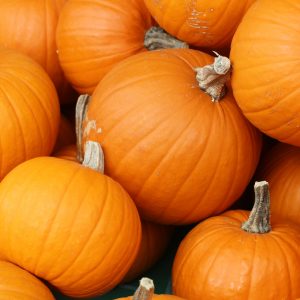Pumpkin Health Benefits
 Pumpkin is an extremely nutrient dense food, which means that it is full of vitamins and minerals but low on calories. There are many creative ways pumpkin can be incorporated into your diet, including desserts, soups, salads, preserves and even as a substitute for butter. When you go shopping for your Halloween pumpkin get an extra one to cook and eat!
Pumpkin is an extremely nutrient dense food, which means that it is full of vitamins and minerals but low on calories. There are many creative ways pumpkin can be incorporated into your diet, including desserts, soups, salads, preserves and even as a substitute for butter. When you go shopping for your Halloween pumpkin get an extra one to cook and eat!
Pumpkin is a member of the Cucurbitaceae family of vegetables (along with cucumber, cantaloupe and squash), and is cultivated around the world for both its fleshy vibrant orange meat and seeds.
According to the USDA National Nutrient database, one cup of pumpkin, cooked, boiled, drained, without salt contains 49 calories, 1.76 grams of protein, 0.17 grams of fat, 0 grams of cholesterol and 12 grams of carbohydrate (including 2.7 grams of fiber and 5.1 grams of sugar).
Pumpkin Health Benefits
- Pumpkin is rich in dietary fiber, which is necessary for good digestion and bowel movements.
- Pumpkin is one of the best-known sources of the powerful antioxidant beta-carotene, which converts into Vitamin A inside the body. Vitamin A is required by the body to maintain skin integrity and mucosa and is essential for good eyesight. Consuming foods rich in beta-carotene may reduce the risk of developing certain types of cancer, offer protection against asthma and heart disease, and delay aging and body degeneration.
- Pumpkin is a good source of the B-complex group of vitamins including niacin, vitamin B-6 (pyridoxine), thiamin, and pantothenic acid. The B vitamins are needed for energy, memory and for many enzymatic reactions in the body.
- Pumpkin is a rich source of copper, calcium, potassium, and phosphorus which are all necessary for proper function of our heart, muscles and cells.
- Pumpkin seeds provide dietary fiber and pack a powerful mix of protein, minerals, and vitamins: 100g (1 cup) of pumpkin seeds provide 559 calories, 30g of protein, plus folate, iron, niacin, selenium, and zinc. The seeds have been noted to be especially helpful for calming the brain due to it’s source of the amino acids tryptophan and glutamate.
Delicious Pumpkin Recipes
Banana Pumpkin Power Smoothie
- 1/3 cup pureed pumpkin
- 2/3 cup soy milk or almond milk
- 1 frozen banana
- 1/4 teaspoon cinnamon
- 1 teaspoon agave or honey
- 1 teaspoon chia seeds
- Small handful of kale
- 2 ice cubes
- Optional: 1 scoop of your favorite protein powder.
Blend and sip!
Pumpkin Bread
Yield: 2 loaves
Preheat oven to 350°F
Butter and flour two 9x5x3 inch loaf pans
Ingredients:
- 1 1/2 cups all-purpose flour (or gluten-free flour mix)
- 1 1/2 cups whole wheat flour (or gluten-free flour mix)
- 1 tsp ground cloves
- 1 tsp ground cinnamon
- 1 tsp ground nutmeg
- 1 tsp baking soda
- 1/2 tsp salt
- 1/2 tsp baking powder
- 2 cups raw sugar (or raw honey)
- 1 cup sunflower oil
- 3 large eggs (room temp)
- 15 oz. (1 can) pure pumpkin
- 1 cup chopped walnuts (optional)
Directions:
Sift first eight ingredients into a large bowl. In second bowl, beat sugar and oil to blend, and then add eggs and pumpkin. Mix well. Stir dry ingredients into pumpkin mixture in two additions, just until blended. Add nuts, if desired. Divide between loaf pans. Bake approximately 1 hour 10 minutes, or until tester inserted into center comes out clean. Transfer to racks and cool in pans for 10 minutes. Cut around sides of pan with a knife to loosen. Turn loaves onto rack to cool completely.
[cws_button type=default size=mini link=http://www.wholeness.com/blog ]Back To Blog Home[/cws_button]
REFERENCES:
- Medical News Today. “What Are the Health Benefits of Pumpkin?” Updated August 30, 2014. http://www.medicalnewstoday.com/articles/279610.php
- World’s Healthiest Foods. “Pumpkin Seeds.” http://www.whfoods.com/genpage.php?tname=foodspice&dbid=82
- Nutrition-and-you.com
- Wu K, Erdman JW Jr, Schwartz SJ, Platz EA, Leitzmann M, Clinton SK, DeGroff V, Willett WC, Giovannucci, E. (2004). Plasma and dietary carotenoids, and the risk of prostate cancer: a nested case-control study, Cancer Epidemiol Biomarkers Prev, Feb;13(2):260-9

Leave a Reply